technical data SKODA FABIA 2010 2.G / 5J Owner's Guide
[x] Cancel search | Manufacturer: SKODA, Model Year: 2010, Model line: FABIA, Model: SKODA FABIA 2010 2.G / 5JPages: 244, PDF Size: 29.53 MB
Page 62 of 244
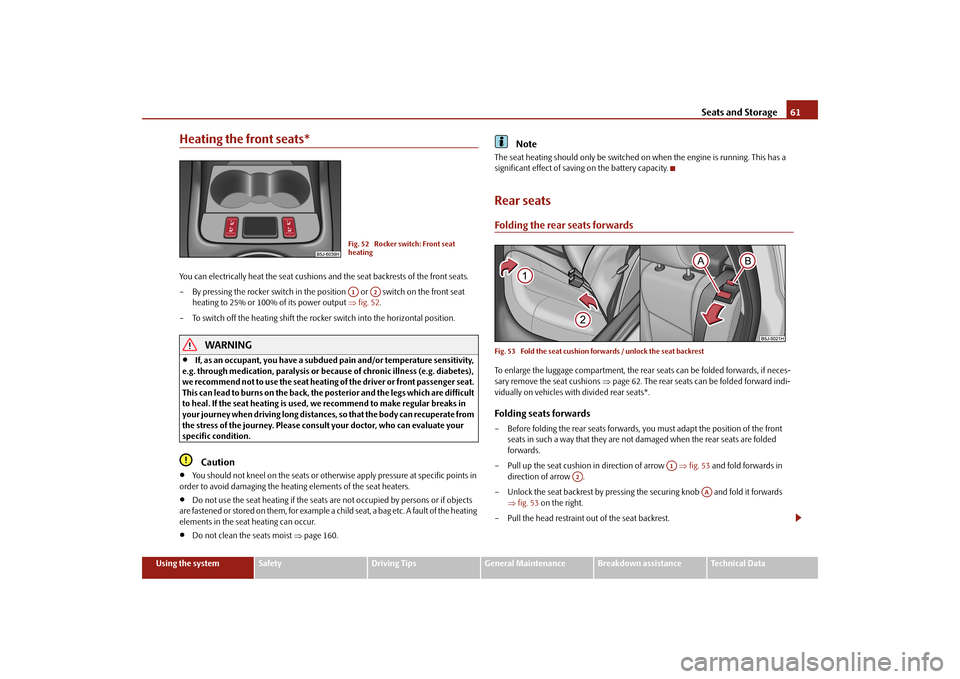
Seats and Storage
61
Using the system
Safety
Driving Tips
General Maintenance
Breakdown assistance
Technical Data
Heating the front seats*You can electrically heat the seat cushions and the seat backrests of the front seats. – By pressing the rocker switch in the posi
tion or switch on the front seat
heating to 25% or 100% of its power output
fig. 52
.
– To switch off the heating shift the rocker switch into the horizontal position.
WARNING
If, as an occupant, you have a subdued
pain and/or temperature sensitivity,
e.g. through medication, paralysis or beca
use of chronic illness (e.g. diabetes),
we recommend not to use the seat heating of the driver or front passenger seat. This can lead to burns on the back, the
posterior and the legs
which are difficult
to heal. If the seat heating is used, we
recommend to make regular breaks in
your journey when driving long distances,
so that the body can recuperate from
the stress of the journey. Please consult your doctor, who can evaluate your specific condition.
Caution
You should not kneel on the seats or otherwise apply pressure at specific points in
order to avoid damaging the heating elements of the seat heaters.
Do not use the seat heating if the seats are not occupied by persons or if objects
are fastened or stored on them, for example a child seat, a bag etc. A fault of the heating elements in the seat heating can occur.
Do not clean the seats moist
page 160.
Note
The seat heating should only be switched
on when the engine is running. This has a
significant effect of saving
on the battery capacity.
Rear seatsFolding the rear seats forwardsFig. 53 Fold the seat cushion forwards / unlock the seat backrestTo enlarge the luggage compartment, the rear
seats can be folded forwards, if neces-
sary remove the seat cushions
page 62. The rear seats can be folded forward indi-
vidually on vehicles with divided rear seats*.Folding seats forwards– Before folding the rear seats forwards, yo
u must adapt the position of the front
seats in such a way that they are not damaged when the rear seats are folded forwards.
– Pull up the seat cushion in direction of arrow
fig. 53
and fold forwards in
direction of arrow .
– Unlock the seat backrest by pressing th
e securing knob and fold it forwards
fig. 53
on the right.
– Pull the head restraint out of the seat backrest.
Fig. 52 Rocker switch: Front seat heatingA1
A2
A1
A2
AA
s3j8.a.book Page 61 Tuesday, April 20, 2010 1:10 PM
Page 64 of 244
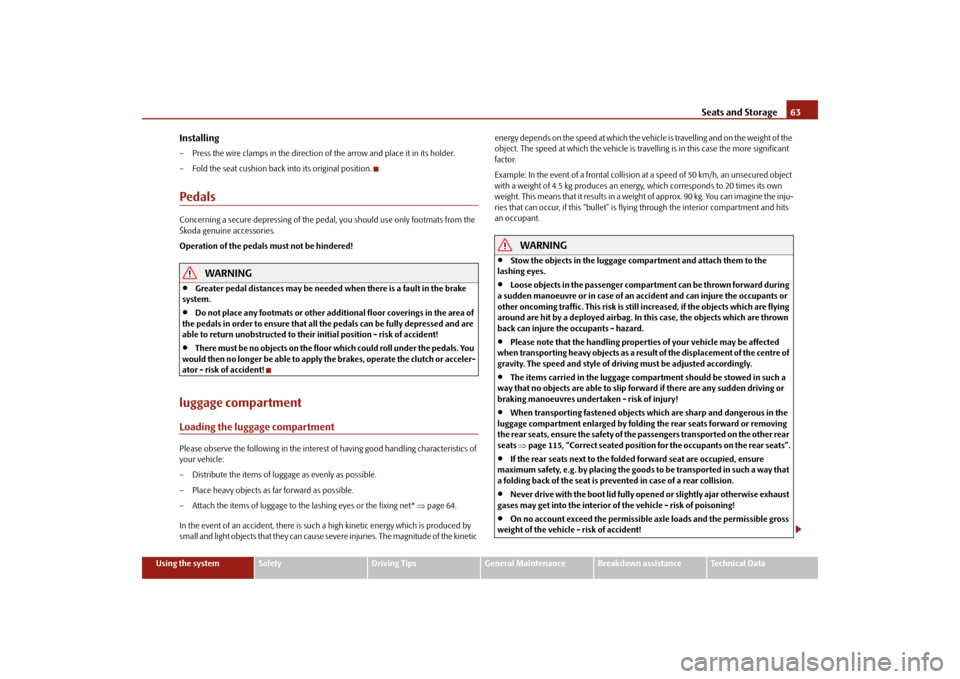
Seats and Storage
63
Using the system
Safety
Driving Tips
General Maintenance
Breakdown assistance
Technical Data
Installing– Press the wire clamps in the direction
of the arrow and place it in its holder.
– Fold the seat cushion back into its original position.PedalsConcerning a secure depressing of the peda
l, you should use only footmats from the
Škoda genuine accessories. Operation of the pedals must not be hindered!
WARNING
Greater pedal distances may be needed when there is a fault in the brake
system.
Do not place any footmats or other additional floor coverings in the area of
the pedals in order to ensure that all the pedals can be fully depressed and are able to return unobstructed to their initial position - risk of accident!
There must be no objects on the floor
which could roll under the pedals. You
would then no longer be able to apply
the brakes, operate the clutch or acceler-
ator - risk of accident!luggage compartmentLoading the luggage compartmentPlease observe the following in the interest of having good handling characteristics of your vehicle: – Distribute the items of luggage as evenly as possible.– Place heavy objects as far forward as possible.– Attach the items of luggage to the
lashing eyes or the fixing net*
page 64.
In the event of an accident, there is such a
high kinetic energy wh
ich is produced by
small and light objects that th
ey can cause severe injuries. The magnitude of the kinetic
energy depends on the speed at which the vehicle is travelling and on the weight of the object. The speed at which the vehicle is trave
lling is in this case the more significant
factor. Example: In the event of a frontal collision at a speed of 50 km/h, an unsecured object with a weight of 4.5 kg produces an en
ergy, which corresponds to 20 times its own
weight. This means that it results in a weight of approx. 90 kg. You can imagine the inju- ries that can occur, if this “bullet” is flyi
ng through the interior compartment and hits
an occupant.
WARNING
Stow the objects in the luggage compartment and attach them to the
lashing eyes.
Loose objects in the passenger compartment can be thrown forward during
a sudden manoeuvre or in case of an accident and can injure the occupants or other oncoming traffic. This risk is still increased, if the objects which are flying around are hit by a deployed airbag. In this case, the objects which are thrown back can injure the occupants - hazard.
Please note that the handling properties of your vehicle may be affected
when transporting heavy objects as a result
of the displacement of the centre of
gravity. The speed and style of driv
ing must be adjusted accordingly.
The items carried in the luggage compartment should be stowed in such a
way that no objects are able to slip fo
rward if there are any sudden driving or
braking manoeuvres underta
ken - risk of injury!
When transporting fastened objects
which are sharp and dangerous in the
luggage compartment enlarged by folding the rear seats forward or removing the rear seats, ensure the safety of th
e passengers transported on the other rear
seats
page 115, “Correct seated position for the occupants on the rear seats”.
If the rear seats next to the folded
forward seat are occupied, ensure
maximum safety, e.g. by placing the goods to be transported in such a way that a folding back of the seat is prevented in case of a rear collision.
Never drive with the boot lid fully open
ed or slightly ajar otherwise exhaust
gases may get into the interior of the vehicle - risk of poisoning!
On no account exceed the permissible
axle loads and the permissible gross
weight of the vehicle - risk of accident!
s3j8.a.book Page 63 Tuesday, April 20, 2010 1:10 PM
Page 66 of 244
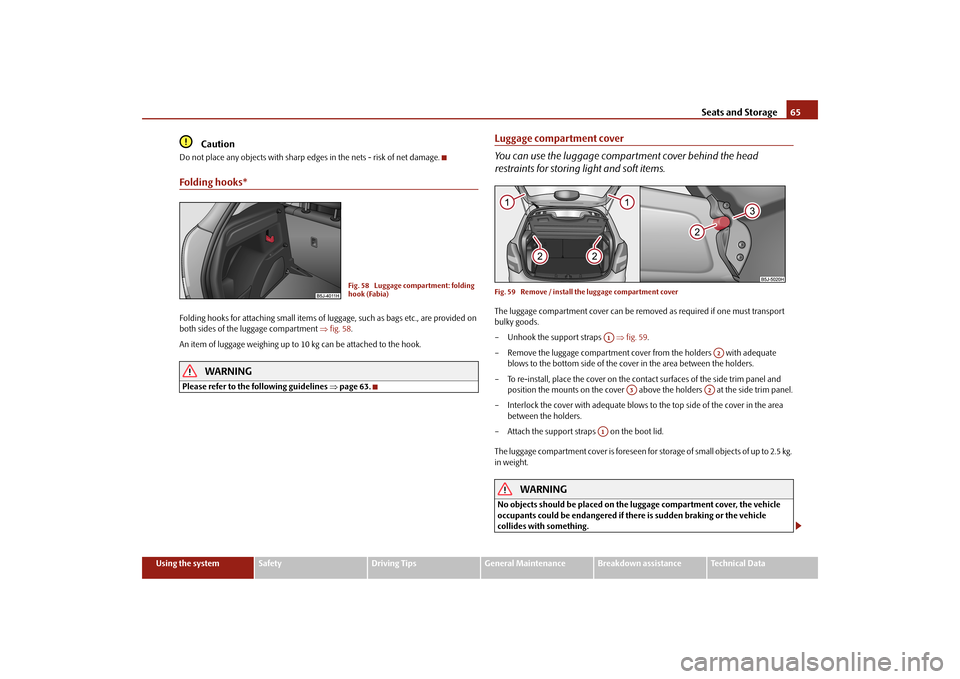
Seats and Storage
65
Using the system
Safety
Driving Tips
General Maintenance
Breakdown assistance
Technical Data
Caution
Do not place any objects with sharp edges in the nets - risk of net damage.Folding hooks*Folding hooks for attaching small items of lu
ggage, such as bags etc., are provided on
both sides of the luggage compartment
fig. 58
.
An item of luggage weighing up to
10 kg can be attached to the hook.
WARNING
Please refer to the following guidelines
page 63.
Luggage compartment cover You can use the luggage compartment cover behind the head restraints for storing
light and soft items.
Fig. 59 Remove / install the luggage compartment coverThe luggage compartment cover can be remo
ved as required if one must transport
bulky goods. – Unhook the support straps
fig. 59
.
– Remove the luggage compartment cover from the holders with adequate
blows to the bottom side of the cove
r in the area between the holders.
– To re-install, place the cover on the cont
act surfaces of the side trim panel and
position the mounts on the cover above
the holders at the side trim panel.
– Interlock the cover with adequate blows to
the top side of the cover in the area
between the holders.
– Attach the support straps on the boot lid. The luggage compartment cover is foreseen for
storage of small objects of up to 2.5 kg.
in weight.
WARNING
No objects should be placed on the
luggage compartment cover, the vehicle
occupants could be endangered if th
ere is sudden braking or the vehicle
collides with something.
Fig. 58 Luggage compartment: folding hook (Fabia)
A1
A2
A3
A2
A1
s3j8.a.book Page 65 Tuesday, April 20, 2010 1:10 PM
Page 68 of 244
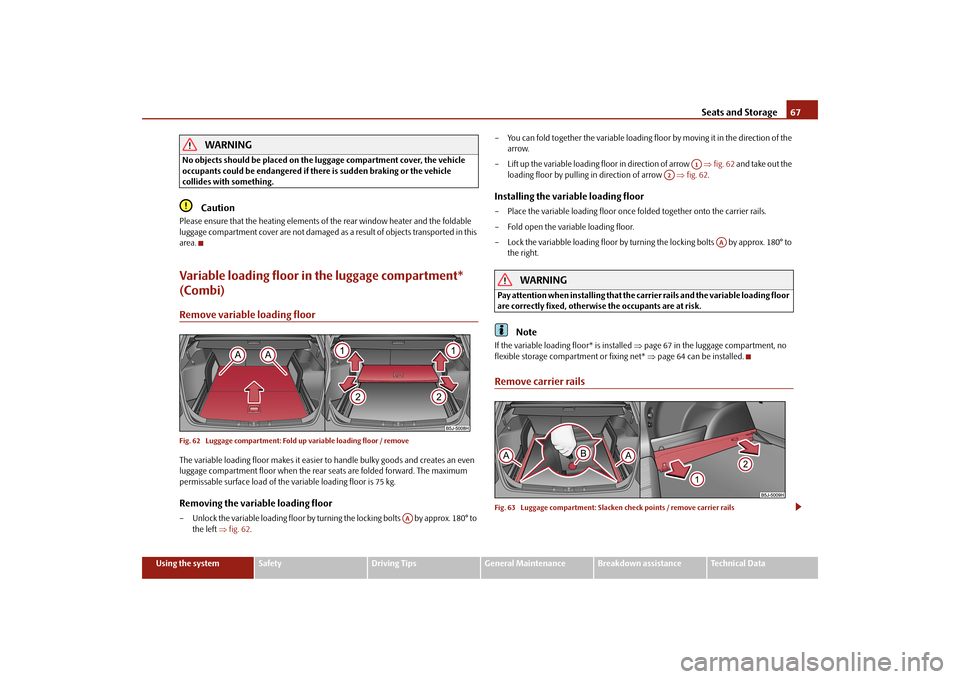
Seats and Storage
67
Using the system
Safety
Driving Tips
General Maintenance
Breakdown assistance
Technical Data
WARNING
No objects should be placed on the luggage compartment cover, the vehicle occupants could be endangered if th
ere is sudden braking or the vehicle
collides with something.
Caution
Please ensure that the heating elements of the rear window heater and the foldable luggage compartment cover are not damaged as
a result of objects transported in this
area.Variable loading floor in the luggage compartment* (Combi)Remove variable loading floorFig. 62 Luggage compartment: Fold up variable loading floor / removeThe variable loading floor makes it easier to handle bulky goods and creates an even luggage compartment floor when the rear seats are folded forward. The maximum permissable surface load of the variable loading floor is 75 kg.Removing the variable loading floor– Unlock the variable loading floor by turning the locking bolts by approx. 180° to
the left
fig. 62
.
– You can fold together the variable loading
floor by moving it in the direction of the
arrow.
– Lift up the variable loading floor in direction of arrow
fig. 62
and take out the
loading floor by pulling in direction of arrow
fig. 62
.
Installing the variable loading floor– Place the variable loading floor once
folded together onto the carrier rails.
– Fold open the variable loading floor.– Lock the variabble loading floor by turning the locking bolts by approx. 180° to
the right.
WARNING
Pay attention when installing that the ca
rrier rails and the va
riable loading floor
are correctly fixed, otherwis
e the occupants are at risk.
Note
If the variable loading floor* is installed
page 67 in the luggage compartment, no
flexible storage compartment or fixing net*
page 64 can be installed.
Remove carrier railsFig. 63 Luggage compartment: Slacken
check points / remove carrier rails
AA
A1
A2
AA
s3j8.a.book Page 67 Tuesday, April 20, 2010 1:10 PM
Page 70 of 244
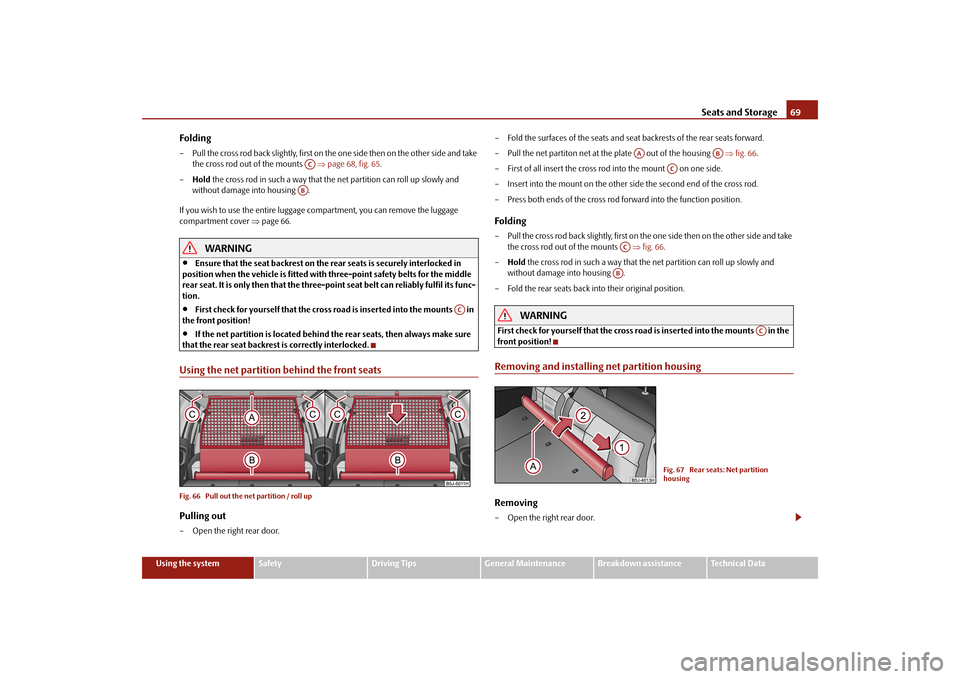
Seats and Storage
69
Using the system
Safety
Driving Tips
General Maintenance
Breakdown assistance
Technical Data
Folding– Pull the cross rod back slightly, first on the one side then on the other side and take
the cross rod out of the mounts
page 68, fig. 65
.
–
Hold
the cross rod in such a way that the net partition can roll up slowly and
without damage into housing .
If you wish to use the entire luggage
compartment, you can remove the luggage
compartment cover
page 66.
WARNING
Ensure that the seat backrest on the rear seats is securely interlocked in
position when the vehicle is fitted with three-point safety belts for the middle rear seat. It is only then that the three-point seat belt can reliably fulfil its func-tion.
First check for yourself that the cross road is inserted into the mounts in
the front position!
If the net partition is located behind th
e rear seats, then always make sure
that the rear seat backrest is correctly interlocked.Using the net partition behind the front seatsFig. 66 Pull out the net partition / roll upPulling out– Open the right rear door.
– Fold the surfaces of the seats and seat backrests of the rear seats forward. – Pull the net partiton net at the plate out of the housing
fig. 66
.
– First of all insert the cross rod into the mount on one side.– Insert into the mount on the other side the second end of the cross rod.– Press both ends of the cross rod
forward into the function position.
Folding– Pull the cross rod back slightly, first on the one side then on the other side and take
the cross rod out of the mounts
fig. 66
.
–
Hold
the cross rod in such a way that the net partition can roll up slowly and
without damage into housing .
– Fold the rear seats back into their original position.
WARNING
First check for yourself that the cross road is inserted into the mounts in the front position!Removing and installing net partition housingRemoving– Open the right rear door.
ACAB
AC
AA
AB
AC
ACAB
AC
Fig. 67 Rear seats: Net partition housing
s3j8.a.book Page 69 Tuesday, April 20, 2010 1:10 PM
Page 72 of 244

Seats and Storage
71
Using the system
Safety
Driving Tips
General Maintenance
Breakdown assistance
Technical Data
Put bicycle into the bicycle carrierFig. 70 Put in the bicycle / fastening the front wheel– Remove the front wheel before putti
ng the bicycle into the vehicle.
– Slacken the quick tension jack on the fixi
ng axle of the bicycl
e carrier and adjust
according to the width
of the bicycle fork.
– Fit the bicycle fork onto
the fixing axle and tighten with the quick tension jack
fig. 70
.
– Position the left pedal of the bicycle forward, in order to attach the front wheel
more easily.
– Slacken the screw
page 70, fig. 69
and push the bicycle
holder together with
the attached bicycle to the le
ft (in the direction of the arrow), so that no collision
between the steering arm and the side wi
ndow of the luggage compartment can
occur.
– Carefully guide the boot lid to the bottom
without letting it go and at the same time
check if there is adequate room between
the steering arm of the bicycle and the
window of the boot lid. If necessary adapt
the position of the moveable part of the
bicycle carrier in such a way that no collision can occur
page 70.
– It is best to push the removed front wheel between the crank of the left pedal and
the bicycle frame, attach it wi
th a strap to the front fork
fig. 70
, and/or to a fixing
point.
– Make sure that it does not lead to da
mage of the trim panel of the luggage
compartment, the bicycle and the placed objects.
– Perform the installation of the second
fixture and the attachment of the bicycle
analogously.
WARNING
Place the bicycles in the bicycle carrier in such a position that no collision between the steering arm and the side
and/or rear window can occur.
Note
If the front wheel is equipped with disc brake, attach the wheel in such a way that the brake disc is opposite the frame.Secure the stability of the bicycles with a strapFig. 71 Securing the bicycles with clamps / securing the bicycles with a strap– To slacken the rubber part of the clamp,
push both parts against each other and
open the clamp.
– Position the clamp with the rubber part to the front (in direction of travel) as far as
possible below the saddle
rod and close the clamp
fig. 71
.
– When transporting two bi
cycles tension the strap
fig. 71
between the saddle
rods, by pushing the bicycles apart.
– Hang the carabines at the ends of the strap into the lashing eyes behind the rear
seats.
– Pull the strap through the tensioning clasp,
first of all on the one side and then on
the other side.
AA
s3j8.a.book Page 71 Tuesday, April 20, 2010 1:10 PM
Page 74 of 244
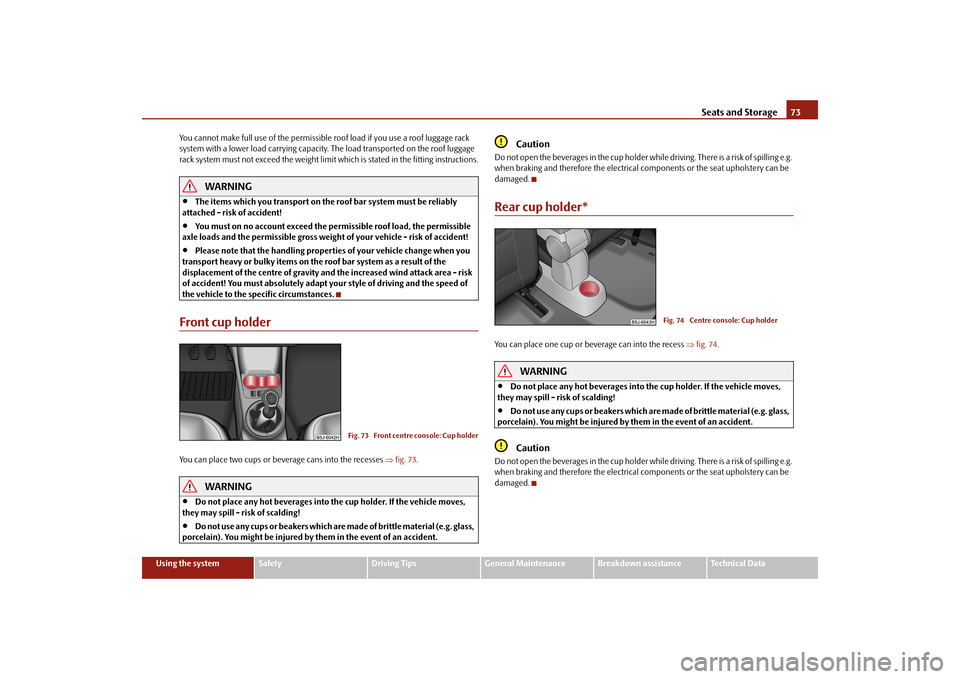
Seats and Storage
73
Using the system
Safety
Driving Tips
General Maintenance
Breakdown assistance
Technical Data
You cannot make full use of the permissible ro
of load if you use a roof luggage rack
system with a lower load carrying capacity
. The load transported on the roof luggage
rack system must not exceed the weight limit which is stated in the fitting instructions.
WARNING
The items which you transport on the roof bar system must be reliably
attached - risk of accident!
You must on no account exceed the pe
rmissible roof load, the permissible
axle loads and the permissible gross weight
of your vehicle - risk of accident!
Please note that the handling properties of your vehicle change when you
transport heavy or bulky items on the roof bar system as a result of the displacement of the centre of gravity an
d the increased wind attack area - risk
of accident! You must absolutely adapt your style of driving and the speed of the vehicle to the sp
ecific circumstances.
Front cup holderYou can place two cups or beverage cans into the recesses
fig. 73
.
WARNING
Do not place any hot beverages into th
e cup holder. If the vehicle moves,
they may spill - risk of scalding!
Do not use any cups or beakers which are
made of brittle material (e.g. glass,
porcelain). You might be injured by them in the event of an accident.
Caution
Do not open the beverages in the cup holder whil
e driving. There is a risk of spilling e.g.
when braking and therefore the electrical components or the seat upholstery can be damaged.Rear cup holder*You can place one cup or beverage can into the recess
fig. 74
.
WARNING
Do not place any hot beverages into th
e cup holder. If the vehicle moves,
they may spill - risk of scalding!
Do not use any cups or beakers which are
made of brittle material (e.g. glass,
porcelain). You might be injured by
them in the event of an accident.
Caution
Do not open the beverages in the cup holder whil
e driving. There is a risk of spilling e.g.
when braking and therefore the electrical components or the seat upholstery can be damaged.
Fig. 73 Front centre console: Cup holder
Fig. 74 Centre console: Cup holder
s3j8.a.book Page 73 Tuesday, April 20, 2010 1:10 PM
Page 76 of 244
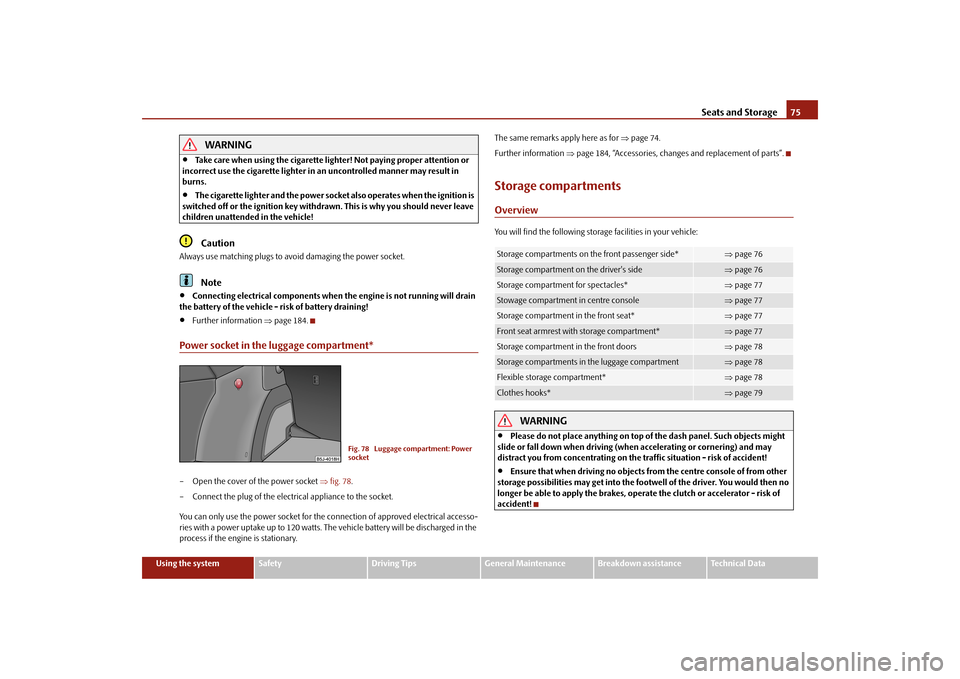
Seats and Storage
75
Using the system
Safety
Driving Tips
General Maintenance
Breakdown assistance
Technical Data
WARNING
Take care when using the cigarette ligh
ter! Not paying proper attention or
incorrect use the cigarette lighter in
an uncontrolled manner may result in
burns.
The cigarette lighter and the power socket
also operates when the ignition is
switched off or the ignition key withdrawn. This is why you should never leave children unattended in the vehicle!
Caution
Always use matching
plugs to avoid damagi
ng the power socket.
Note
Connecting electrical components when
the engine is not running will drain
the battery of the vehicle - risk of battery draining!
Further information
page 184.
Power socket in the luggage compartment*– Open the cover of the power socket
fig. 78
.
– Connect the plug of the electr
ical appliance to the socket.
You can only use the power socket for the connection of approved electrical accesso- ries with a power uptake up to 120 watts. The vehicle battery will be discharged in the process if the engine is stationary.
The same remarks apply here as for
page 74.
Further information
page 184, “Accessories, changes and replacement of parts”.
Storage compartmentsOverviewYou will find the following storag
e facilities in your vehicle:
WARNING
Please do not place anything on top of the dash panel. Such objects might
slide or fall down when driving (whe
n accelerating or cornering) and may
distract you from concentrating on the traffic situation - risk of accident!
Ensure that when driving no objects from the centre console of from other
storage possibilities may get into the fo
otwell of the driver. You would then no
longer be able to apply the brakes, oper
ate the clutch or accelerator - risk of
accident!
Fig. 78 Luggage compartment: Power socket
Storage compartments on the front passenger side*
page 76
Storage compartment on the driver's side
page 76
Storage compartment for spectacles*
page 77
Stowage compartment in centre console
page 77
Storage compartment in the front seat*
page 77
Front seat armrest with storage compartment*
page 77
Storage compartment in the front doors
page 78
Storage compartments in the luggage compartment
page 78
Flexible storage compartment*
page 78
Clothes hooks*
page 79
s3j8.a.book Page 75 Tuesday, April 20, 2010 1:10 PM
Page 78 of 244
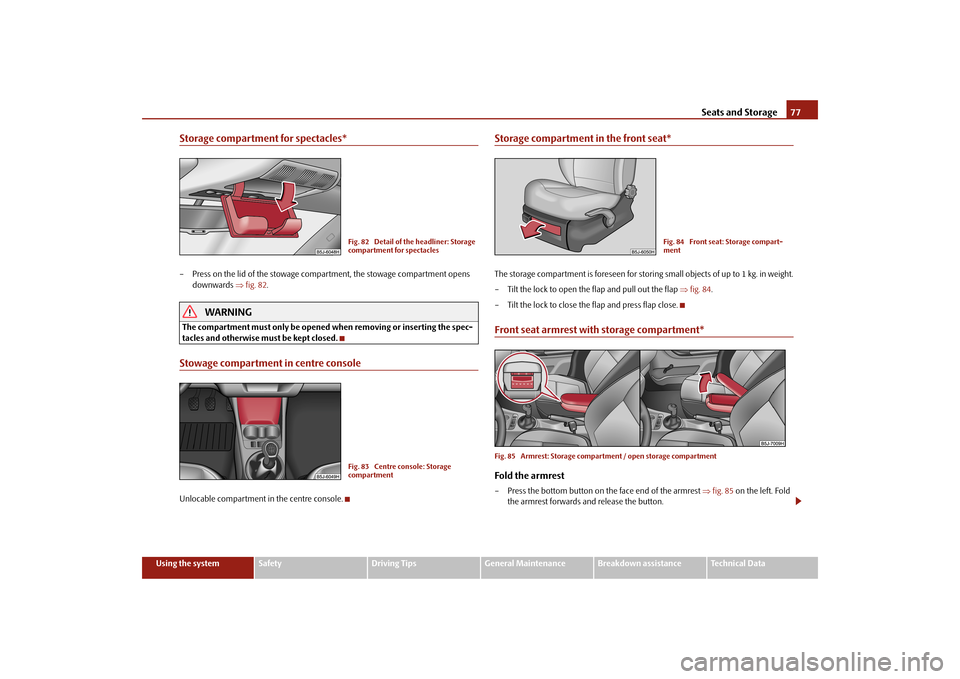
Seats and Storage
77
Using the system
Safety
Driving Tips
General Maintenance
Breakdown assistance
Technical Data
Storage compartment for spectacles*– Press on the lid of the stowage comp
artment, the stowage compartment opens
downwards
fig. 82
.
WARNING
The compartment must only be opened
when removing or inserting the spec-
tacles and otherwise must be kept closed.Stowage compartment in centre consoleUnlocable compartment in the centre console.
Storage compartment in the front seat*The storage compartment is foreseen for storing small objects of up to 1 kg. in weight. – Tilt the lock to open the flap and pull out the flap
fig. 84
.
– Tilt the lock to close the flap and press flap close.Front seat armrest with storage compartment*Fig. 85 Armrest: Storage compar
tment / open storage compartment
Fold the armrest– Press the bottom button on the face end of the armrest
fig. 85
on the left. Fold
the armrest forwards and release the button.
Fig. 82 Detail of the headliner: Storage compartment for spectacles Fig. 83 Centre console: Storage compartment
Fig. 84 Front seat: Storage compart- ment
s3j8.a.book Page 77 Tuesday, April 20, 2010 1:10 PM
Page 80 of 244
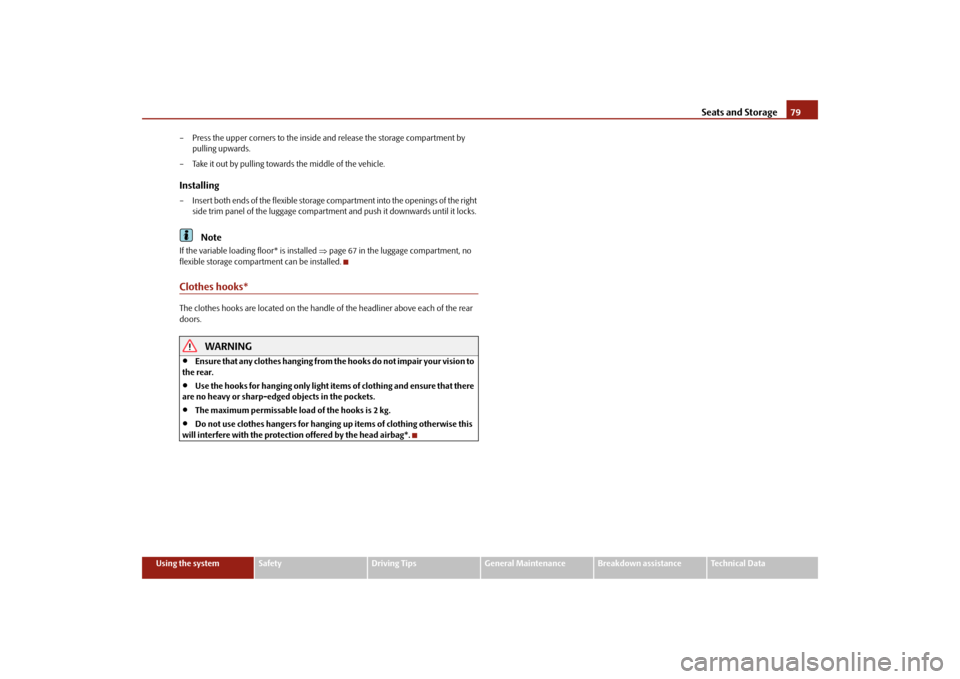
Seats and Storage
79
Using the system
Safety
Driving Tips
General Maintenance
Breakdown assistance
Technical Data
– Press the upper corners to the inside
and release the storage compartment by
pulling upwards.
– Take it out by pulling toward
s the middle of the vehicle.
Installing– Insert both ends of the flexible storage
compartment into the openings of the right
side trim panel of the luggage compartmen
t and push it downwards until it locks.
Note
If the variable loading floor* is installed
page 67 in the luggage compartment, no
flexible storage compartment can be installed.Clothes hooks*The clothes hooks are located on the handle of the headliner above each of the rear doors.
WARNING
Ensure that any clothes hanging from the hooks do not impair your vision to
the rear.
Use the hooks for hanging only light item
s of clothing and ensure that there
are no heavy or sharp-edge
d objects in the pockets.
The maximum permissable load of the hooks is 2 kg.
Do not use clothes hangers for hanging up items of clothing otherwise this
will interfere with the protection offered by the head airbag*.
s3j8.a.book Page 79 Tuesday, April 20, 2010 1:10 PM